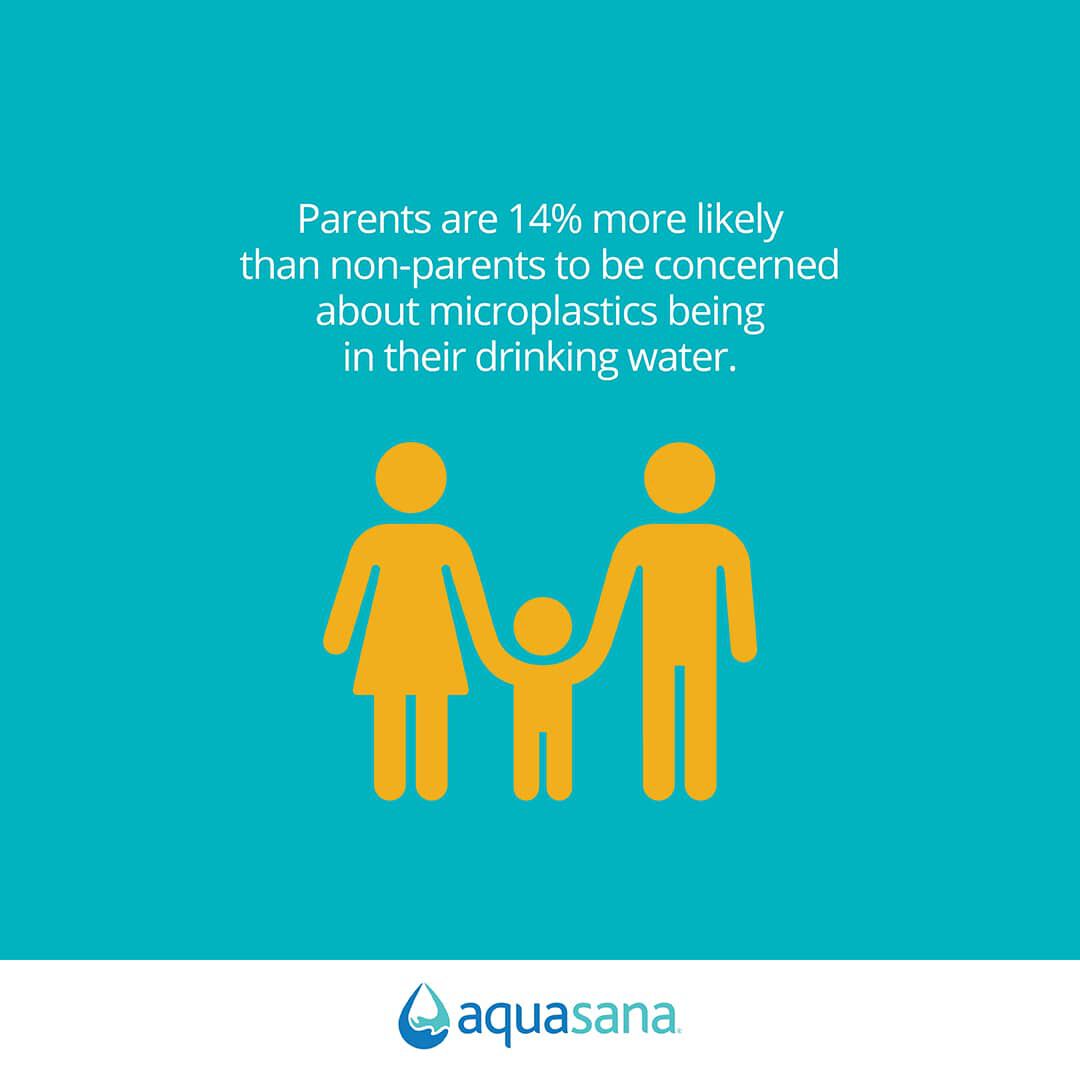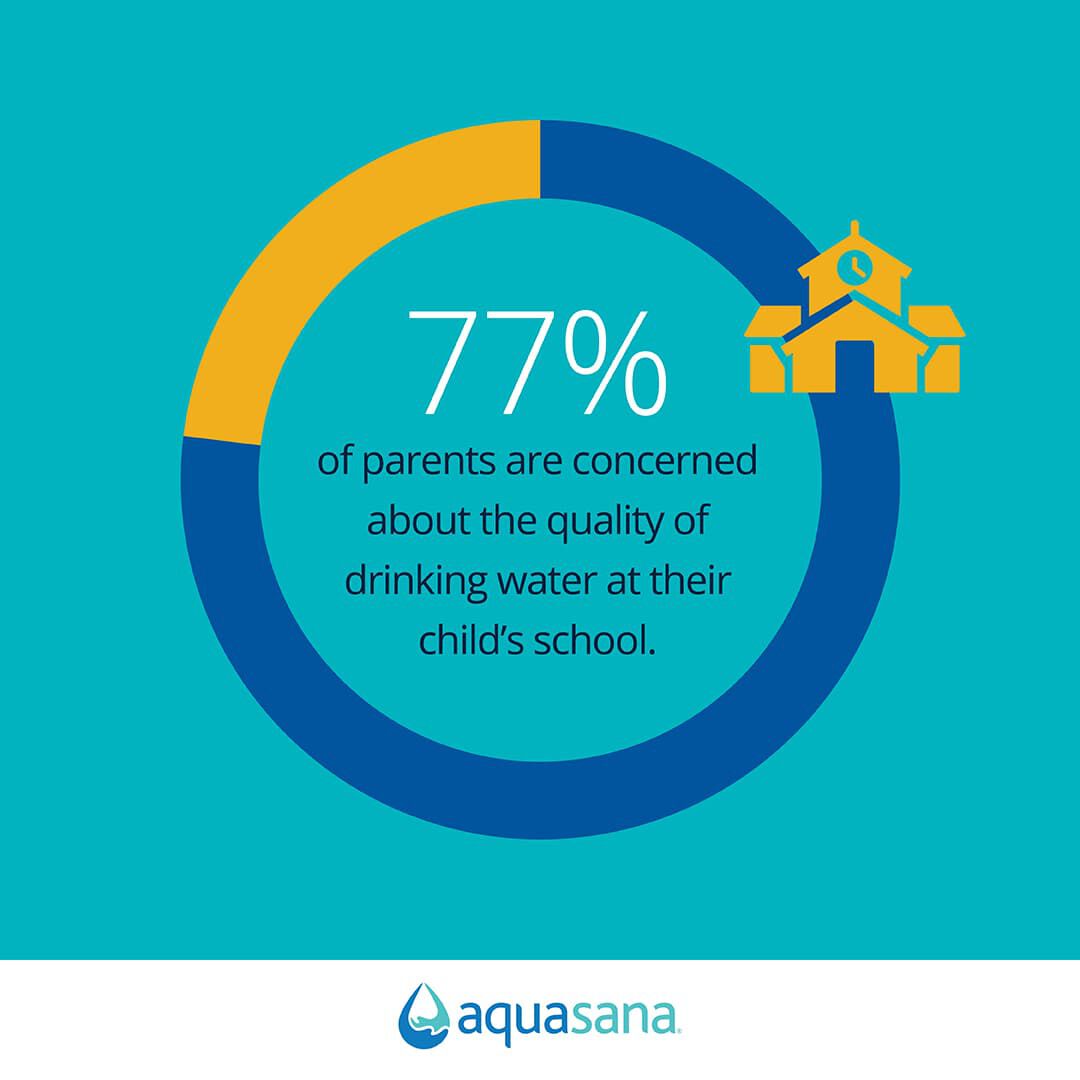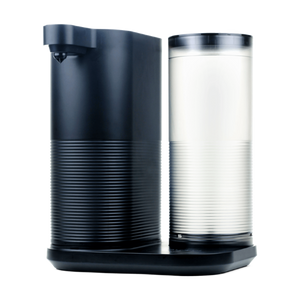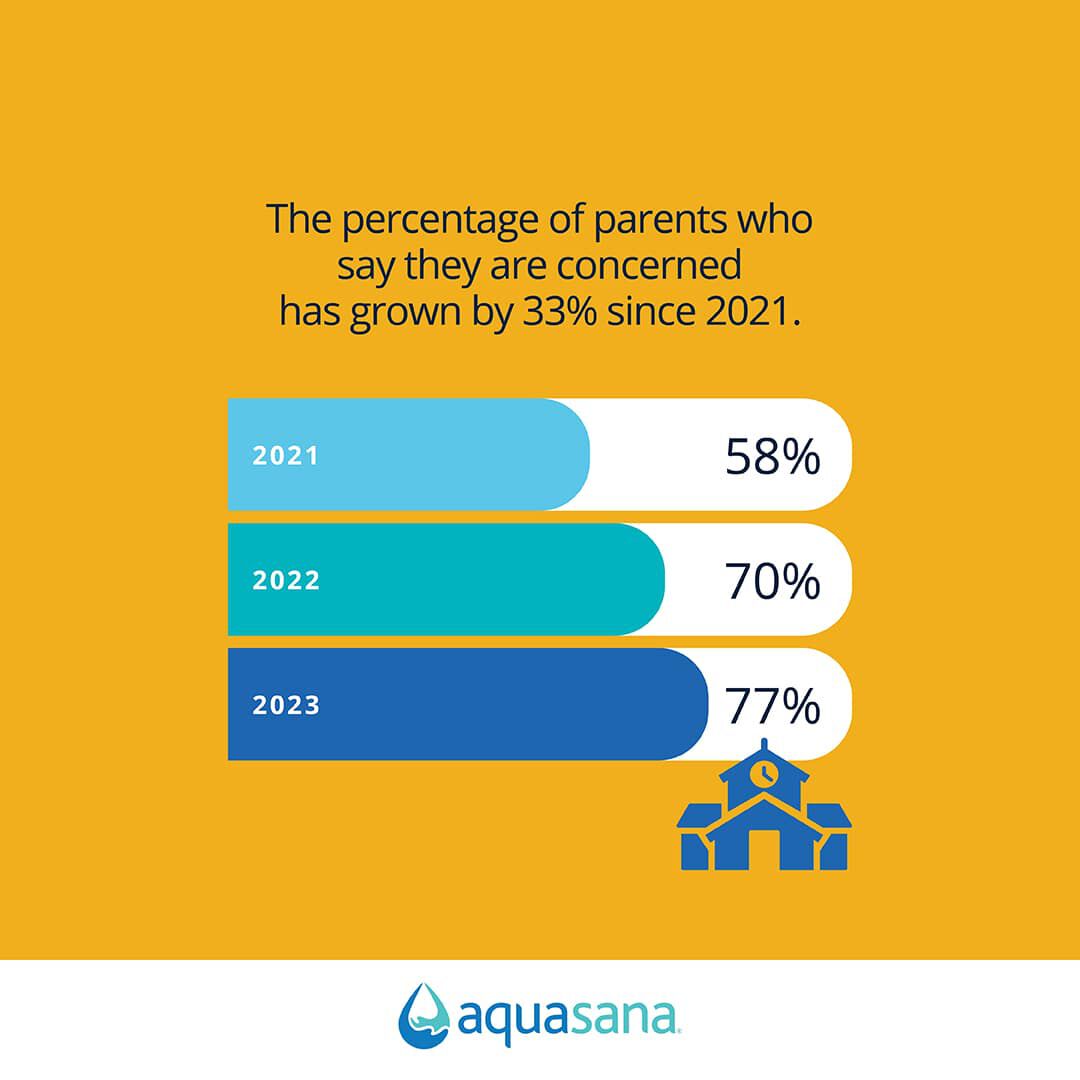
Increased knowledge about water quality
This year, we saw a prominent increase in the percentage of parents who say they know a lot about the quality of unfiltered tap water at home. We believe parents’ growing knowledge around water quality correlates with their rising concern about it, an idea that’s further supported by data discussed in our previous survey post from this year.
In 2023, we found that nearly half (48%) of parents say they know a lot about the quality of unfiltered tap water in their home, a figure that’s up from just 35% the previous year. The percentage of parents who claim to be informed about water quality (48%) is also significantly higher than the percentage of non-parents who feel the same (32%), showing parents feel more knowledgeable about water quality.
Outside of general knowledge related to water quality, we also found parents are more familiar and concerned than non-parents about certain types of water contaminants like PFOA/PFOS and microplastics.
PFOA/PFOS
PFOA/PFOS is a rising concern for Americans as a whole, but especially for parents. In 2023 94% of parents reported being familiar with these chemicals as they relate to water, a figure that’s steadily increased over the last four years from just 35% in 2020 (marking a 169% increase in that time).
As we’ve seen before, parents are a step ahead here with how much they know. In each of those four years, we’ve seen a higher percentage of parents who are familiar with PFOA/PFOS compared to non-parents. It is interesting to see the significant spike in familiarity within non-parents this year, but despite that uptick, they still lag behind parents. It’s possible that recent water contamination events have captured the attention of non-parents, but most parents were already familiar with the chemicals before the coverage.
We also found parents are particularly concerned about PFOA/PFOS. In 2023, 16% of parents rated it as their top water contaminant concern, and parents were 60% more likely than non-parents to do so. This concern has also grown considerably over the past year, as just 6% of parents rated PFOA/PFOS as their top water contaminant concern in 2022. This could be related to recent PFAS contamination events in the news and studies being released about the extent of exposure, such as a new federal report that found these “forever chemicals” could be in nearly half of U.S. tap water supplies.
Microplastics
Microplastics are another trending topic, and similar to PFOA/PFOS — parents are more likely to be familiar with and concerned about microplastics than non-parents. In 2023, we found that nearly all (97%) parents say they are at least somewhat familiar with microplastics, compared to only 89% of non-parents. Furthermore, 20% of parents say they are extremely familiar with the contaminant, which is significantly higher than the 12% of non-parents who said the same.
Reiterating the hypothesis that knowledge correlates to concern, we found that 92% of parents are concerned about microplastics being in their drinking water. Before jumping into more data, let’s digest that for a moment. We found that 97% of parents are familiar with microplastics, and 92% are concerned about them — meaning that almost every parent who has knowledge of the contaminant is concerned about it. That’s almost a 1:1 correlation between knowledge and concern, as only 5% of parents who were familiar with microplastics were not concerned about them being in their drinking water.
Getting back to the comparison of parents vs. non-parents, we found that only 81% of non-parents were concerned about microplastics being in their drinking water. So parents tend to be more familiar with microplastics and have a higher level of concern (at a nearly 1:1 rate) compared to non-parents. Parents and non-parents have access to the same information, so why the discrepancy? It’s because becoming a parent changes a person’s mindset.

Becoming a parent changes the way you think about water quality
Having a child literally changes peoples’ brains, meaning they think differently than they did before becoming parents. It’s a phenomenon commonly referred to as mom or dad brain, and there’s considerable scientific evidence backing it up.
For example, one study found new mothers see growth in their prefrontal cortex, which is responsible for learning, planning, and judgment. Research also shows that the brain reduces gray matter and neurons (a process known as synaptic pruning), which can actually make it operate more efficiently. These effects aren’t isolated to mothers, as researchers say becoming a father creates changes in mens’ processing and other brain functions.
These brain changes affect the way parents think, and this can include thoughts and concerns about water quality. In 2023, 88% of surveyed parents said that having a child has made them more concerned about water contamination issues. This means that nearly 9 out of 10 Americans have become more concerned about water quality because of having a child, and this figure has also increased each of the last three years.
In 2023, 25% of parents also said they filter their drinking water because they experienced a major life change (like having a baby), compared to only 19% of non-parents. Parents were also more likely than non-parents (82% vs. 76%) to say it’s important for their health to have access to clean, trustworthy tap water at home.
Going back to how becoming a parent changes the way a person thinks about water quality, we believe it’s because parents see the need to provide clean, healthy drinking water for their children’s health.
Water quality issues at U.S. schools
Capping off our reasons behind heightened parent concerns about water quality, is the occurrence of water quality issues at schools across the country. There have been several high-profile cases of lead being detected in drinking water at public schools, with some at concerning levels.
For example, state officials from Montana mandated their schools test for lead, and 74% of the schools that submitted samples found at least one faucet with high levels of lead. The state is facing a crisis, as they’re trying to identify the source of the problem while also finding funds to fix it. Montana isn’t alone, as a 2023 study from Environment America Research & Policy Center gave most states failing scores for their policies related to lead contamination in schools’ drinking water, including schools in rural towns and major cities. The study also found that “most schools have at least some lead in their pipes, plumbing or fixtures.”

In 2021, only 18 states had mandatory testing for lead in school drinking water, while 23 states had voluntary programs, and the states that do test for lead lack uniformity in how it’s done. State protocols vary on things like how tests are conducted and how much lead in water triggers a response. For parents, this may be enough to discourage their children from using fountains at school.
Incidents like these keep lead as a prominent contaminant in the eyes of parents, as 16% of them said it was their top water contaminant concern in 2023.
The importance of drinking clean, trustworthy water at school and home
Access to clean, healthy water is essential for everyone, but especially children for a few reasons. According to the EPA, children are very sensitive to contaminants that affect the brain’s development because of their developing nervous systems. Beyond sensitivity, children also have higher exposure to drinking water contaminants because they tend to take in more water relative to their body weight than adults.
Moving away from the risks, the CDC also notes the following benefits of clean water for children:
- Improved memory and attention
- Help maintaining a healthy weight
- Reduced risk of chronic diseases
- Help preventing cavities
There’s also new research that suggests an association between hydration and mental health, including mood and cognitive performance. To help ensure your family has access to clean water at home, school, or on the go — we’ll share some tips while discussing additional survey findings.
Filter water at home with a trustworthy system
Proper hydration starts with water you can trust, and due to parents’ growing concerns about unfiltered tap water — many are choosing to filter their drinking water at home. In fact, an overwhelming 96% of parents filter their drinking water at home. This figure has also increased each of the last four years, up from just 78% in 2020.
Since 2020, we’ve seen a 23% increase in the percentage of parents who filter their drinking water at home (78% vs. 96%)
- 2020: 78%
- 2021: 85%
- 2022: 88%
- 2023: 96%
Similar to other results, parents are also more likely to filter their drinking water at home than non-parents (96% vs. 82%). We also found that 82% of parents find it necessary to filter their tap water at home, which is more than the percent of non-parents (71%) who felt the same. We see the same trend here as above, as the percentage of parents who agree it’s necessary to filter their tap water at home has increased over time, from just 69% in 2020.
From 2020 to 2023, we’ve seen a 19% increase in the percentage of parents who agree that it’s necessary to filter tap water in their home (82% vs. 69%)
- 2020: 69%
- 2021: 70%
- 2022: 81%
- 2023: 82%
Filtering your tap water at home is the start of healthy hydration habits, as parents can ensure their child has access to a source of clean drinking water. However, what do you do when your child leaves the house? We’ve got you covered.
Bottle filtered water from home and send it with them, or use a filtered water bottle
When kids are outside of the home, say at school or a friend’s house, parents need a way to ensure they have access to clean water. There are two ways to do this. The first is simple, just fill up a reusable water bottle with filtered water from your home. All you need is a bottle and a reliable system, like the Clean Water Machine, which reduces 15x contaminants of the leading pitcher filter including lead and PFOA/PFOS. You definitely want a filter at home so this solution seems like a no-brainer, but what happens if your child runs out of water while away from the house?
COUNTERTOP WATER FILTER
Clean Water Machine
Claryum® technology filters 78 contaminants including lead and PFAS at the push of a button. No installation.

The Children’s Hospital of Orange County (CHOC) recommends kids drink the number of 8-ounce cups of water equal to their age, with a minimum of 64 ounces for children over the age of 8. Water bottles tend to be around 16 ounces, so a single bottle may not be enough to last throughout the day.
To ensure your child always has access to clean water, it could be worth investing in a bottle with a built-in filter like our Stainless Steel Insulated Clean Water Bottle. The bottle removes up to 99% of lead, chlorine, bacteria, and other contaminants from tap water so your child can fill up anywhere and have access to clean water throughout the day.
Key takeaways
From our survey data, we found that parents are growing increasingly concerned about water quality at their children’s schools and at home. We believe the heightened concern can be traced to three factors. First, is the growing knowledge about water quality including insight about specific contaminants. Second, is the way becoming a parent changes the way a person thinks, as they may be more concerned about factors that could be detrimental to their children’s health. Third and finally, is because there are several recent cases of water quality issues at schools making rounds in the news, and a lack of solutions from lawmakers.
Throughout our data, we found that parents were consistently more knowledgeable, more concerned, and more likely to take actions to improve their water quality compared to non-parents.
Children have heightened risk of negative health effects from unsafe water, and supplying clean water can mitigate those risks while also providing numerous physical and mental health benefits. As a result, it’s important for parents to provide access to clean, trustworthy drinking water for their children when they’re at home or on the go. We’ve provided tips, but for more information, check out our Info Center for additional guidance.
Survey methodology and definitions
The findings presented in this article are the result of an April 2023 study of 2,414 U.S. adults, conducted by Aquasana. (Confidence Level: 95%, Margin of Error: 2%)
Parents (U.S. adults with dependents under the age of 18 living in their homes)
- Confidence Level: 95%, Margin of Error: 2%


